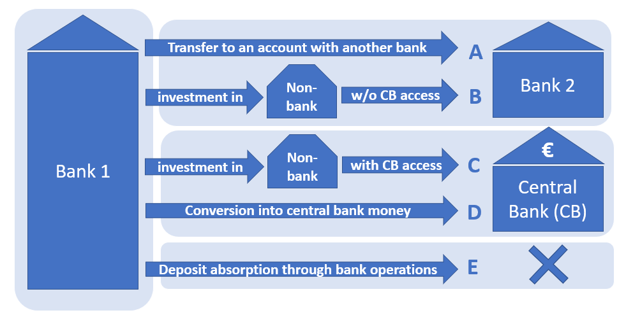References
Arsov, Ana and Jill Cetina (2023), “Funding risks, weaker profitability and turn in asset quality will test bank credit strength”, Moody’s US banks sector in-depth, 7. August 2023.
Baer, Greg and Bill Nelson (2023), “Why Is the Federal Reserve Abetting a Drain of Deposits from Banks?”, Bank Policy Institute, 29 March 2023.
Bindseil, Ulrich and Edoardo Lanari (2022)”, “Fire Sales, the LOLR, and Bank Runs with Continuous Asset Liquidity,” Journal of Financial Crises: Vol. 4 : Iss. 4, 77-102. Available at: https://elischolar.library.yale.edu/journal-of-financial-crises/vol4/iss4/3
Bindseil, Ulrich and Richard Senner (2023), „Destabilisation of Bank Deposits Across Destinations – Assessment and Policy Implications”, September 7th, 2023. https://papers.ssrn.com/sol3/papers.cfm?abstract_id=4534754
Bowman, Michelle W (2023), “The Evolving Nature of Banking, Bank Culture, and Bank Runs”, Speech given at the 21st Annual Symposium on Building the Financial System of the 21st Century: An Agenda for Europe and the United States, European Central Bank, Frankfurt, Germany, May 12, 2023.
Cecchetti, Stephen G. and Kermit L. Schoenholtz (2023), “Making Banking Safe”. Available at SSRN: https://ssrn.com/abstract=4513903 or http://dx.doi.org/10.2139/ssrn.4513903
Enria, Andrea (2023), “Interview with Andrea Enria, Chair of the Supervisory Board of the ECB, conducted by Francesco Ninfole”, 22 July 2023, ECB Banking Supervision. https://www.bankingsupervision.europa.eu/press/interviews/date/2023/html/ssm.in230722~111bdb656b.en.html
FED (2023), “Federal Reserve Board announces it will make available additional funding to eligible depository institutions to help assure banks have the ability to meet the needs of all their depositors”, Press release, March 12, 2023.
IMF (2018) Euro Area Financial Assessment Program, Technical Note – Systemic Liquidity Management, Country Report No. 2018/229.
Panetta, Fabio (2022), “The digital euro and the evolution of the financial system”, Introductory statement at the Committee on Economic and Monetary Affairs of the European Parliament, Brussels, 15 June 2022. https://www.ecb.europa.eu/press/key/date/2022/html/ecb.sp220615~0b859eb8bc.en.html
OECD (2011), “Bank competition and financial stability”, report.
Restoy, Fernando (2023), “The quest for deposit stability”, BIS Speech at EFDI International Conference, Budapest, Hungary, 25 May 2023. https://www.bis.org/speeches/sp230525.htm
Rochet, Jean-Charles, and Xavier Vives (2004), “Coordination Failures and the Lender of Last Resort: Was Bagehot Right after All?”, Journal of the European Economic Association 2 (6): 1116–47.
Senner, Richard and Didier Sornette (2021), “Explaining global imbalances: the role of central-bank intervention and the rise of sovereign wealth funds”, Review of Keynesian Economics, vol. 9, issue 1, 61-82.
SNB (2023), “Financial Stability Report”, Swiss National Bank, available online.





